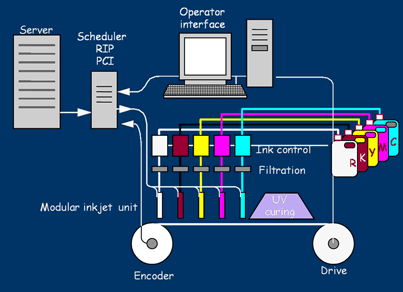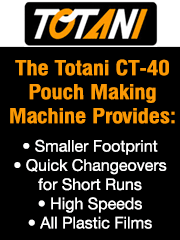Packaging Must Open Up to Single-Pass Inkjet
- Published: July 31, 2005, By Rob Haak, SPIKIX
August Web Exclusive
Think back to last year's Drupa. Everyone went expecting it to be “The JDF Drupa,” but when they got there, they found that inkjet was the real showstopper.
This was not a surprise to those of us working on inkjet, but it was good to see what we knew confirmed on such an international stage. In recent years inkjet has made big strides, and single-pass drop-on-demand full-color printing systems are emerging as credible competitors to current technology in many sectors. They offer alternatives to electro-photography at the high end; to all types of conventional printing technology for small- to medium-volumes of print-on-demand, just-in-time and customized or personalized print; to continuous inkjet for industrial marking, and in the transactional printing and business color markets. In fact, I believe inkjet soon will be the driving technology for digital production of newspapers.
The foundations of this bridgehead have been laid by the technology suppliers: the very robust, high-speed industrial inkjet head manufacturers, the high-reliability and high-performance ink vendors, the builders of the precision transport systems, and the developers of the digital front end software. And to combine all these components into a neat integrated digital printing solution we have the systems integrators, tuning here, tweaking there, studying the specific requirements of the end-user and creating fit-for-purpose applications in the appropriate sectors.

So far, digital inkjet printing solutions have enjoyed most success in short-run printing and print-on-demand applications, where the market, after over a decade of evangelizing by suppliers and commentators, understands that digital is, by definition, the only way to work. Looking ahead, however, we see enormous potential for integrating single-pass inkjet printing in the form of a matrix of stationary print heads above a transport system for the material and into production and manufacturing lines in the converting and packaging markets.
A number of factors are converging to bring this about. So far as the technology is concerned, the non-contact inkjet printing solutions that are now available from several vendors will work with most of the different inks (UV, oil- or water-based) and print on a wide range of industrial substrates. Furthermore, we are seeing steady improvements in resolution, quality, and speed. But beyond the technology, there are other powerful drivers in favor of integrating printing at multiple stages in the product supply chain, including the just-in-time procurement and logistics systems of major retailers, environmental initiatives aimed at reducing packaging, and the demand for customized and regionalized labeling within global distribution models.
These are powerful arguments for consumer producer groups to integrate print activity in the in-line packaging process; these major companies are always looking to serve their customers better, and besides, there are potential cost-savings to be had by further integrating production with customer consumption, reducing lead times, and “versioning” products. Everybody in the “value chain” will benefit from better planned production, reduced levels of stock and work in progress, and a tight connection to the order process.
But the question is: Are the packaging converters willing to go through a rigorous re-engineering of their business processes? Many of these companies have been working for decades with their existing equipment and print technologies, and unfortunately, they do not see the new possibilities. This is a real challenge for those of us who believe in single-pass inkjet.
How can we overcome it? Personally, I believe in what the English thinker Sidney Webb called “the inevitability of gradualness,” the way in which incremental changes can eventually create a revolution. In my opinion, the single-pass inkjet concept will not burst onto the production line in a fully-realized form, but will instead gradually manifest itself as a secondary printing pass, just as it is already used for mono marking and sensing applications today. It might be used for variable data color printing on labels and packaging—for example, to produce packages in different languages, list ingredients, promote different marketing messages, and so on. As these applications become more common, they will generate other ideas—think, for example, about the potential of developments on the horizon for the direct jetting of metallic inks and RFID (radio frequency identification) inks.
I noted earlier that over the past decade there has been no shortage of evangelists for the benefits of digital printing for commercial short-run and POD work. Single-pass digital inkjet printing needs such evangelism now, and organizations have started to spread the word. All we ask is that the packaging industry opens its ears and its mind.

Rob Haak is president of Netherlands-based SPIKIX, a management consultancy specializing in the industrial market for single-pass inkjet printing solutions. Rob has more than 16 years of experience in the digital printing industry, working for a "Who's Who" of leading-edge companies that include Barco Graphics, dotrix, and Agfa. He has spoken at international conferences sponsored by the Information Management Institute (IMI), the Society for Imaging and Technology (IS&T), the Inst. for International Research (IIR), and photokina's World of Imaging. Contact him at rob@spikix.com.











